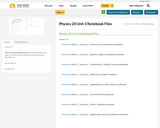
Lessons 1-9
- Subject:
- Physics
- Science
- Material Type:
- Activity/Lab
- Lesson
- Date Added:
- 10/18/2018

Lessons 1-9
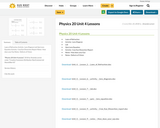
Laws of Refraction
Activity- Lens Diagram
Lab
Quiz Lens Equation
Activity- Cow Eye Dissection Report
Notes- How does your Eye
Notes- Defects of Vision
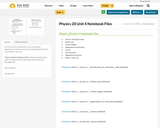
Intro to refraction & labs
Snell's Law
Critical Angles
Applications of refraction
Lenses
Lens Equation
Application of Lenses
Notes- colour, etc
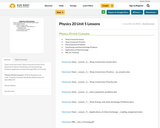
Temp Conversion humor
Temp Conversion Practice
Extra Expansion Problems
Total Energy and Heat Exchange Problems
Applications of Heat Exchange
PBL am i Freezing
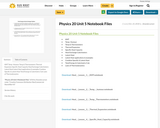
KMT
Temp- Humour
Temp & Thermometers
Thermal Expansion
Specific Heat Capacity
Heat Exchange Calorimeters
Latent Heat
Latent Heat applications & examples
Combine Specific & Latent Heat
Total Energy & Calorimetry Calc
Laws of Thermodynamics

The following resources are assignments and worksheets for Wave unit in physics 20.

Terminology and the Universal Wave Equation
Wave Interference
Transmission and Reflection of Waves
Standing Waves
Harmonics
Unit 5 Exam
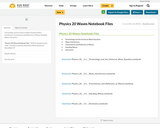
Terminology and the Universal Wave Equation
Wave Interference
Transmission and Reflection of Waves
Standing Waves
Harmonics
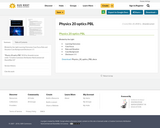
Blinded by the Light
Learning Outcomes
Case Focus
Role and Situation
Case Background
Disclosure 1-5

The Physics 205/206 and 210/211 sequences are intended for biology majors. If you're an engineering major, you should be in Physics 221. If you just need a gen ed class, you should be in Physics 130. Physics 205/206 satisfies your physics requirement if you're a biology major transferring to a Cal State. The prerequisites for 205 are Math 141 (precalculus) and Math 142 (trig). Physics 210/211 satisfies your physics requirement if you're a biology major transferring to a UC (or a Cal State). The prerequisites for 210 are Math 141 (precalculus) and Math 142 (trig), and the corequisite is Math 150A (calculus).
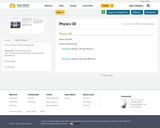
Physics 30 and PI
Physics 30 Nuclear PBL
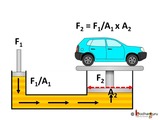
This Physics video explains the Application of Pascal's Law in Hydraulics.

In this unit of study, students will design, build, program, and test a small fan-powered "robot" created with an Arduino controller. The drone must move a certain distance, then stop. This unit integrates nine STEM attributes and was developed as part of the South Metro-Salem STEM Partnership's Teacher Leadership Team. Any instructional materials are included within this unit of study.
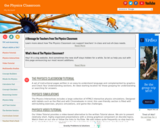
A wealth of resources for teaching and learning about physics!
Tutorials, interactives, videos, multimedia info, concept builders, concept checkers, question bank HELP and more!

This 10-minute video lesson looks at Newton's First Law (Galileo's Law of Inertia).

TED Studies, created in collaboration with Wiley, are curated video collections 逖 supplemented by rich educational materials 逖 for students, educators and self-guided learners. The Edge of Knowledge explores the fascinating implications of some of science's most perplexing theories: quantum mechanics, general relativity and attempts to unify them. Learn how scientists combine sophisticated mathematics and ambitious experimentation like CERN逭s Large Hadron Collider to advance our understanding of the universe.

In this activity, students will learn about Newton's 2nd Law of Motion. They will learn that the force required to move a book is proportional to the weight of the book. Engineers use this relationship to determine how much force they need to move an airplane.

cK-12 Exploration Series offers Physics and Chemistry simulations to support visualization of abstract concepts. Teachers would need to create an account.

From drinking fountains at playgrounds, water systems in homes, and working bathrooms at schools to hydraulic bridges and levee systems, fluid mechanics are an essential part of daily life. Fluid mechanics, the study of how forces are applied to fluids, is outlined in this unit as a sequence of two lessons and three corresponding activities. The first lesson provides a basic introduction to Pascal's law, Archimedes' principle and Bernoulli's principle and presents fundamental definitions, equations and problems to solve with students, as well as engineering applications. The second lesson provides a basic introduction to above-ground storage tanks, their pervasive use in the Houston Ship Channel, and different types of storage tank failure in major storms and hurricanes. The unit concludes with students applying what they have learned to determine the stability of individual above-ground storage tanks given specific storm conditions so they can analyze their stability in changing storm conditions, followed by a project to design their own storage tanks to address the issues of uplift, displacement and buckling in storm conditions.

Students explore the physics utilized by engineers in designing today's roller coasters, including potential and kinetic energy, friction, and gravity. First, students learn that all true roller coasters are completely driven by the force of gravity and that the conversion between potential and kinetic energy is essential to all roller coasters. Second, they also consider the role of friction in slowing down cars in roller coasters. Finally, they examine the acceleration of roller coaster cars as they travel around the track. During the associated activity, the students design, build, and analyze a roller coaster for marbles out of foam tubing.